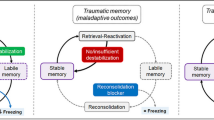Abstract
Rationale.
Animal models of relapse to drug abuse typically assess the ability of various manipulations to reinstate responding that has ceased due to non-reinforcement (extinction). However, there is a lack of information concerning the reinstatement of responding that has ceased for reasons other than extinction.
Objectives.
This study examined the ability of response-independent reinforcer delivery (priming) to reinstate food- or drug-reinforced responding that had been suppressed by response-contingent footshock (punishment).
Methods.
Nose-poke responding by separate groups of rats was reinforced with food (45 mg/delivery) or intravenous remifentanil (4 µg/kg per infusion), a short-acting µ-opioid agonist. After either 3 or 27 days of training (with 100 reinforcers/day), a punishment contingency was introduced that rapidly suppressed responding. Then, the punishment contingency was discontinued, and half the rats received priming.
Results.
Priming by non-contingent delivery of food or remifentanil significantly reduced the number of sessions required for responding to resume. There were no significant differences in this effect between short-term and long-term training or between food- and drug-trained groups.
Conclusions.
Self-administration responding that has been suppressed by punishment can be reinstated by priming, and it can eventually resume even without priming. Under the conditions studied here, priming after punishment had effects qualitatively similar to those typically seen after extinction. This punishment/reinstatement procedure may be useful for comparing the effects of other manipulations known to affect behavior in the extinction/reinstatement model of relapse.




Similar content being viewed by others
References
Ahmed SH, Koob GF (1997) Cocaine- but not food-seeking behavior is reinstated by stress after extinction. Psychopharmacology 132:289–295
Azrin NH, Holz WC (1966) Punishment. In: Honig WK (ed) Operant behavior: areas of research and application. Prentice-Hall, Englewood Cliffs, N.J., pp 380–447
Beck SG, O'Brien JH (1980) Lethal self-administration of morphine by rats. Physiol Behav 25:559–564
Bergman J, Johanson CE (1981) The effects of electric shock on responding maintained by cocaine in rhesus monkeys. Pharmacol Biochem Behav 14:423–426
Bergman J, Katz JL (1998) Behavioral pharmacology of cocaine and the determinants of abuse liability. In: Higgins ST, Katz JL (eds) Cocaine abuse: behavior, pharmacology, and clinical applications. Academic Press, New York, pp 51–79
Brewer C (1993) Recent developments in disulfiram treatment. Alcohol Alcohol 28:383–395
Burman S (1997) The challenge of sobriety: natural recovery without treatment and self-help groups. J Subst Abuse 9:41–61
Carroll ME (1998) Acquisition and reacquisition (relapse) of drug abuse: modulation by alternative reinforcers. NIDA Res Monogr 169:6–25
Childress AR, McLellan AT, O'Brien CP (1985) Behavioral therapies for substance abuse. Int J Addict 20:947–69
Crowley TJ (1985) Doctors' drug abuse reduced during contingency-contracting treatment. Alcohol Drug Res 6:299–307
Cunningham JA, Lin E, Ross HE, Walsh GW (2000) Factors associated with untreated remissions from alcohol abuse or dependence. Addict Behav 25:317–21
Davis WM, Smith SG (1976) Role of conditioned reinforcement in the initiation, maintenance and extinction of drug-seeking behavior. Pavlov J Biol Sci 11:222–36
Dib B, Duclaux R (1982) Intracerebroventricular self-injection of morphine in response to pain in the rat. Pain 13:395–406
Frawley PJ, Smith JW (1992) One-year follow-up after multimodal inpatient treatment for cocaine and methamphetamine dependencies. J Subst Abuse Treat 9:271–286
Fuchs RA, Tran-Nguyen LT, Specio SE, Groff RS, Neisewander JL (2001) Predictive validity of the extinction/reinstatement model of drug craving. Psychopharmacology 135:151–160
Gerber GJ, Stretch R (1975) Drug-induced reinstatement of extinguished self-administration behavior in monkeys. Pharmacol Biochem Behav 3:1055–1061
Goeders GJ, Guerin GF (1994) Non-contingent electric shock facilitates the acquisition of intravenous cocaine self-administration. Psychopharmacology 114:63–70
Grove RN, Schuster CR (1974) Suppression of cocaine self-administration by extinction and punishment. Pharmacol Biochem Behav 2:199–208
Johanson CE (1977) The effects of electric shock on responding maintained by cocaine injections in a choice procedure in the rhesus monkey. Psychopharmacology 53:277–282
Kearns D, Weiss SJ, Panlilio LV (2002). Conditioned suppression of behavior maintained by cocaine self-administration. Drug Alcohol Depend 65:253–261
Klingemann HK (1991) The motivation for change from problem alcohol and heroin use. Br J Addict 86:727–744
Kosten TA, Kosten TR (1991) Pharmacological blocking agents for treating substance abuse. J Nerv Ment Dis 179:583–592
National Research Council (1996) Guide for care and use of laboratory animals. National Academy Press, Washington D.C.
O'Brien CP, Childress AR, Arndt IO, McLellan AT, Woody GE, Maany I (1988) Pharmacological and behavioral treatments of cocaine dependence: controlled studies. J Clin Psychiatry 49:17–22
Panlilio LV, Schindler CW (2000) Self-administration of remifentanil, an ultra-short acting opioid, under continuous and progressive-ratio schedules of reinforcement in rats. Psychopharmacology 150:61–66
Panlilio LV, Weiss SJ, Schindler CW (1996) Cocaine self-administration increased by compounding discriminative stimuli. Psychopharmacology 125:202–208
Schenk S, Partridge B (1999) Cocaine-seeking produced by experimenter-administered drug injections: dose-effect relationships in rats. Psychopharmacology 147:285–290
Shaham Y, Rajabi H, Stewart J (1996) Relapse to heroin-seeking in rats under opioid maintenance: the effects of stress, heroin priming, and withdrawal. J Neurosci 16:1957–1963
Shaham Y, Erb S, Stewart J (2000) Stress-induced relapse to heroin and cocaine seeking in rats: a review. Brain Res Rev 33:13–33
Shalev U, Grimm JW, Shaham Y (2002) Neurobiology of relapse to heroin and cocaine seeking: a review. Pharmacol Rev 54:1–42
Singer JD (1998) Using SAS PROC MIXED to fit multilevel models, hierarchical models, and individual growth models. J Ed Behav Stat 24:323–355
Slikker W Jr, Brocco MJ, Killam KF Jr (1984) Reinstatement of responding maintained by cocaine or thiamylal. J Pharmacol Exp Ther 228:43–52
Smith SG, Davis WM (1974) Punishment of amphetamine and morphine self-administration behavior. Psychol Rec 24:477–480
Spealman RD, Barrett-Larimore RL, Rowlett JK, Platt DM, Khroyan TV(1999) Pharmacological and environmental determinants of relapse to cocaine-seeking behavior. Pharmacol Biochem Behav 64:327–336
Stewart J (2000) Pathways to relapse: the neurobiology of drug- and stress-induced relapse to drug-taking. J Psychiatr Neurosci 25:125–136
Wit H de, Stewart J (1981) Reinstatement of cocaine-reinforced responding in the rat. Psychopharmacology 75:134–143
Author information
Authors and Affiliations
Corresponding author
Rights and permissions
About this article
Cite this article
Panlilio, L.V., Thorndike, E.B. & Schindler, C.W. Reinstatement of punishment-suppressed opioid self-administration in rats: an alternative model of relapse to drug abuse. Psychopharmacology 168, 229–235 (2003). https://doi.org/10.1007/s00213-002-1193-0
Received:
Accepted:
Published:
Issue Date:
DOI: https://doi.org/10.1007/s00213-002-1193-0




